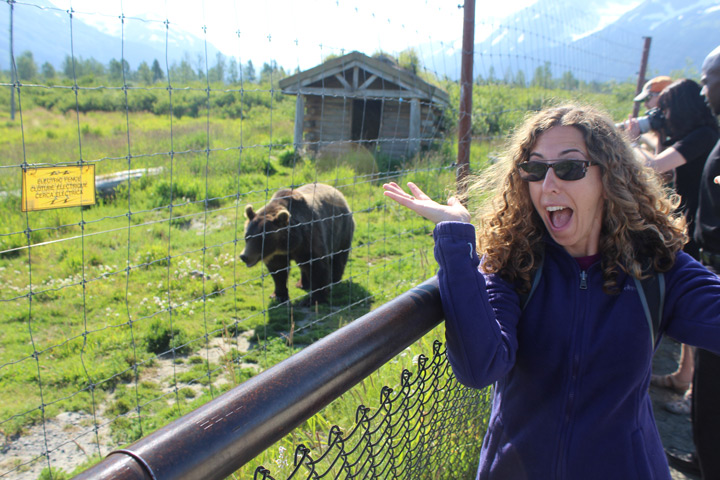Chris & Allyson vs. Alaska (2016)
Chapter Six: Seward and the Kenai Peninsula
In the early days of Alaskan tourism, boat was clearly the way to go. Every settlement worth visiting was on the water, and trips to the interior usually involved an 80 percent chance of death -- if you had a GOOD guide. A visit to "Alaska" actually meant the islands and coastline of the southeast, which statistically speaking is a very tiny portion of Last Frontier.
But there have been tremendous advances in infrastructure and technology over the last 130 years. Today, even the most novice traveler can look to the vast north and enjoy easy access to upwards of 2 percent of the state.
The point is, the size of mainland Alaska can be intimidating. But with a week of vacation to burn and a rental car reserved, Allyson Jaffe and Chris White were going to do their best to see what they could. Especially bears.
Therefore, the second half of our Alaskan adventure had to begin with the acquisition of the rental car. The Celebrity cruise line doesn't mess around. They pulled into the port of Seward early in the morning, and they wanted us off the boat by noon.
I wanted to go even sooner. Our rental car reservation, made online months in advance, was for 7 a.m. With 4.3 gazillion square miles to explore, it seemed prudent to get a jump on things. Instead of leaving our luggage for the stewards and waiting for our appointed "muster out" time, I wanted to carry our bags off the ship first thing in the morning. Allyson was convinced that the rental car place COULDN'T be open that early. But I assured her that I had rented many cars, that they wouldn't let us reserve a car for 7 a.m. if they weren't open, and that she was being a silly and naive wife.
The rental car place was not open.
But we were one of the first couples off the ship! And it was a very soothing half-mile walk to the Hertz facility, pulling our luggage the whole way. And then we had a very relaxing one-hour wait until they unlocked the door of the Hertz office. I have no doubt in my mind that Allyson was thrilled to be sitting outside of that Hertz building in the crisp Alaskan air, while her husband studied maps and tried to avoid admitting any error in judgment.
Our reward for this little adventure was a sweet Toyota Corolla -- the first car to roll off the Hertz lot that morning. And that meant we also had a huge jump on all our former cruisemates in the race to explore Seward! Four minutes later we were done exploring Seward. Like most Alaskan municipalities, it ain't that big. The population is less than 3,000, and you can drive from one end of "downtown" to the other in about 60 seconds (assuming you have a suitably sweet Corolla).
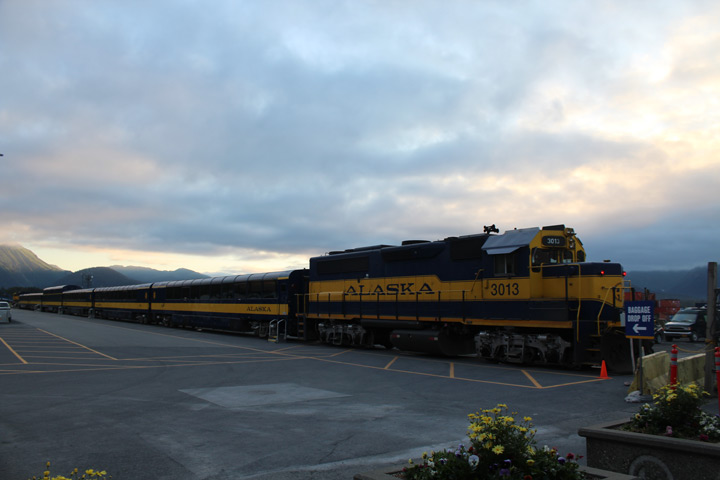
The train from Seward to Anchorage. Which we did not take.
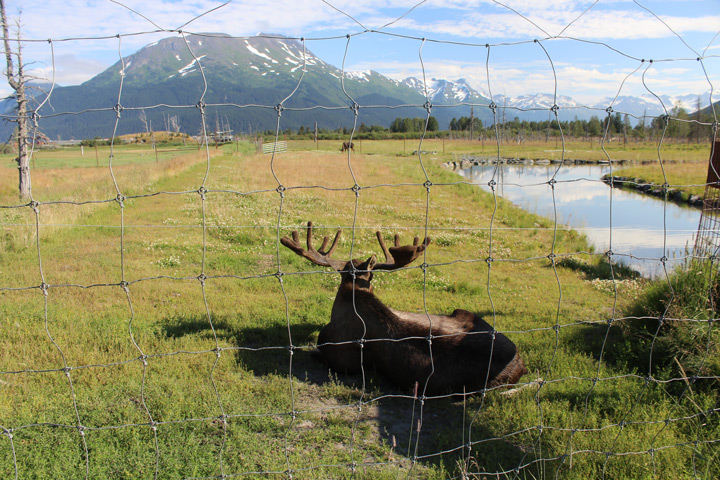
Say hello to the Alaska Wildlife Conservation Center.
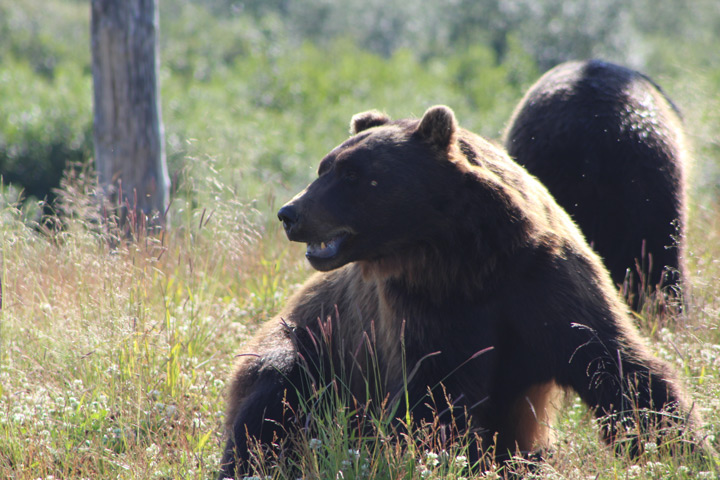
The AWCC has a few grizzlies, romping on a nice semi-natural spread.

Living the Alaskan dream: Getting VERY close to big bears.
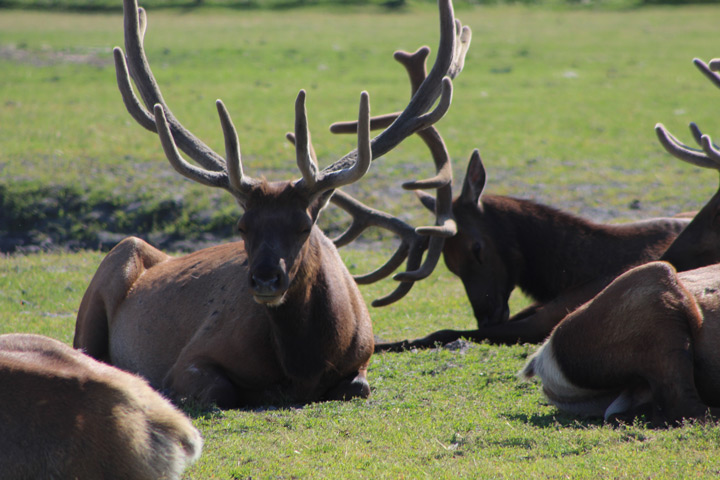
Horny devils at the AWCC.

Checking out the Turnagain Arm at the AWCC.
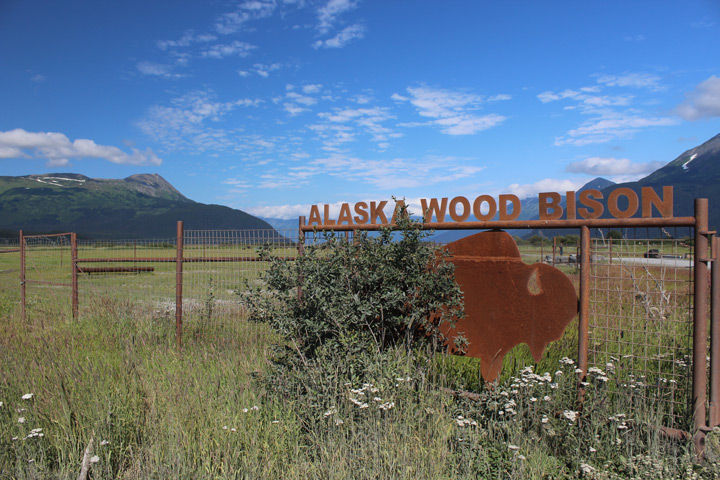
A zoo as scenic as we've ever scene.
But you can't beat the location. Seward sits on Resurrection Bay, a beautiful body of water surrounded on three sides by the stunning mountains of the Kenai Peninsula. There's a scenic vista in every direction, and I don't know that I've ever seen a more beautiful location for any town.
However, beauty is in the eye of the beholder. And in Allyson's case, the beholder needed coffee before listening to her husband yammer on about beauty. The second task for the second part of our vacation was finding somewhere to eat breakfast. Fortunately, someone had a good hour to peruse informational maps and pamphlets about Seward, and those steered us to the Sea Bean, a nice little cafe on Seward's equivalent of a main street. After one scaldingly hot cup of coffee and a light breakfast, we were ready to make the entire vacation worth it.
Success is fuzzy concept -- it can mean whatever you want it to mean. For our vacation, Allyson defined success as seeing bears. As a good husband, it was my job to make sure we succeeded. We MIGHT spot a bear in the wild, but I tried to find something closer to a guarantee. The Alaska Wildlife Conservation Center takes in wounded or distressed animals, gets them in good health and gives the public a chance to see them. It's a zoo, but with very unconventional cages and a feel-good mission. The AWCC is about 80 miles north of Seward, and they have bears.
This was the slam dunk any husband would hope for, so we pointed the Corolla north. And it really WAS that simple. Some places, you have to really study a map or learn your way around. In Alaska, most of the towns are four or five streets wide, and there are really only two major roads. One of those roads goes from Seward to Fairbanks, passing through Anchorage on the way. The other goes from Fairbanks to Whitehorse (in Canada). If you get lost driving in Alaska, you are very stupid, or very drunk, or very bad at driving. I'm only mildly stupid, so within minutes we were on a glide path to the AWCC.
And what a road! The Kenai Peninsula is covered with stunning snow-capped mountains, so every minor bend in the road shows an exciting array of hanging glaciers and striking peaks. We were in a car, so Allyson slept through all of it -- her superpower is falling asleep in cars. But it was breathtaking.
And so was the conservation center. My only hope for the park was the chance to see bears. If the whole facility was a single bear tied to a post 20 feet off the side of the road, I could have declared victory and started writing my acceptance speech for husband of the year.
For a second, that joke seemed like it might be a reality. The entrance to the AWCC was less than impressive, and we actually had to do a U-turn on the highway to find it after missing it on the way north. It turns out that the entrance was a little like the wardrobe leading to Narnia. The AWCC is one of the best zoos we’ve ever seen.
A lot has to do with the setting. The Kenai Peninsula is a rugged and beautiful stretch of land between Cook Inlet on the west and Prince William Sound on the east. Just south of Anchorage (which sits on the Cook Inlet), a long body of water called the Turnagain Arm stretches east and almost touches the Sound. This creates a pinch point that marks the northern end of the Kenai. The AWCC is at the end of the Turnagain Arm, putting it in a geologic "bowl" -- a nice flat tidal plain is surrounded on all sides by textbook-beautiful Alaska mountains. Because Alaska has plenty of square footage, the animal enclosures at the AWCC are also quite large. Instead of being confined to small zoo-type habitats, most of the animals enjoy big fenced-in fields that let them act a little more like animals.
The animals themselves are also nothing to sneeze at. We started by looking at some moose and a porcupine. But those were appetizers. The main course was the bears.
The AWCC has three Alaskan brown bears, all of which loosely fit under the heading of "grizzly." Hugo is a classic grizzly who was sent to the center after being found in the wild with paws full of porcupine quills. Joe Boxer (JB) and Patron are brown bears who were brought in as cubs -- their mother was shot by a homeowner when she wandered into a back yard. The three bears are not going back into the wild, but the AWCC has given them an 18-acre enclosure. It has a few rolling hills, patches covered with brush and bushes, a small pond, and even a Unabomer shed where the bears can write manifestos about salmon. Visitors can watch the bears from a nice observation platform, but if the bears really feel like hiding, they can have their privacy.
Fortunately for us, the bears put on a show during our visit. The brothers did some play fighting and chased each other around one of the hills. Then we headed to a spot just off the viewing platform, alongside the enclosure's fence. All three bears made their way over, as a zoo employee was tossing them dogfood through the fence. (It's a protein boost between meals, which you apparently need when you weigh upwards of 1,500 pounds.) We saw a bear play in the water, we saw a bear stick out its disgusting Lovecraftian tongue, and we got an excellent look at a bear’s terrifying claws. Bears are highly evolved killing machines that somehow pass as giant plush toys.
Allyson was delighted at all of this. I remember looking into her eyes as we said our wedding vows, and she was probably about ten times happier looking at bears. Rather than despair at this knowledge, I accept that in any battle, I will come in second to a huggable tornado of teeth and fur. Personally, I was delighted that we got to experience bears up close with the added amenity of a security fence. It has to be thrilling to encounter bears in the wild, but in that moment you must remember (under duress) whether you fight, play dead or sacrifice the smaller member of your group to buy time.
I am much faster than Allyson, with a longer stride. And while I THINK that I’d protect my wife during a bear attack, I’m perfectly happy to keep that as a hypothetical situation.
We pestered the dog-food-throwing zookeeper for a while, and she gave us general info on the bears and their habits. They live in the enclosure year-round, they aren't going back into the wild, and on occasion they get to gorge on road-kill moose. It's not a bad life, if you're into bloated moose corpses.
There was more zoo to see, so during a pause in the bear action we went for a stroll. The other big highlight of the zoo was probably the wood bison, huge land mammals that were on the verge of extinction. The AWCC bred a herd in captivity and has been reintroducing them to the Alaskan wilderness. The bison still in the AWCC are apparently there for bad behavior, because one of them tried to ram its head through the fence to get at us when we walked close by. They are a menace, and I think we might have been on the right track with that whole extinction thing. We also enjoyed a lovely gazebo positioned at a tidal flat where the Turnagain Arm ends. The gazebo did NOT try to assault me, so I found it even more charming.
On the way out of the park, we were lucky enough to experience the OTHER bears. Right next to the brown bear enclosure (and sharing an observation deck) is the black bear enclosure. Black bears in Alaska aren't particularly more intriguing than black bears anywhere else. They are smaller than Alaskan brown bears and a good deal more timid. They could still kill you before breakfast and not break a sweat, but they're clearly the neglected stepchild of the Alaskan bear family. The AWCC has two of them, and they were napping or hiding in their den when we walked past the first time. The tourist herd had thinned out a little since then, and the noise level was down. So one of them came out for a stroll. He was less entertaining than any of the brown bears, but he gets full marks for showing up.
It was very hard to leave the conservation center and our new best friends, but there was still 99.78 percent of Alaska left to see. And even with 20 hours of sunshine, we were still burning daylight.

Seeing the Russian Orthodox influence in Kenai.
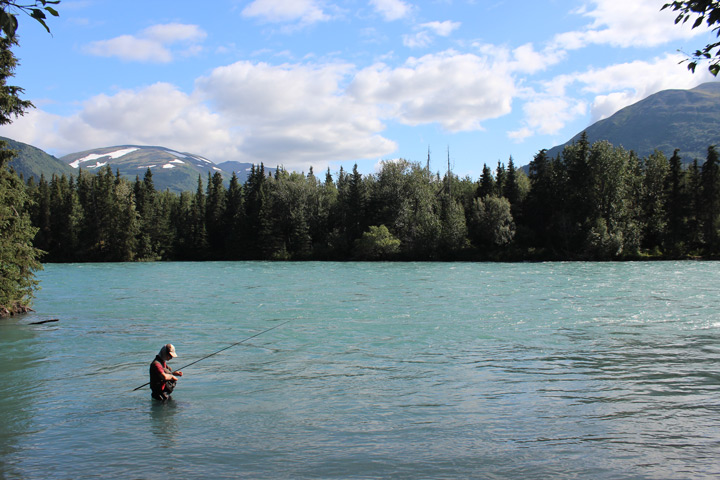
Salmon fishing in the beautiful Russian River.
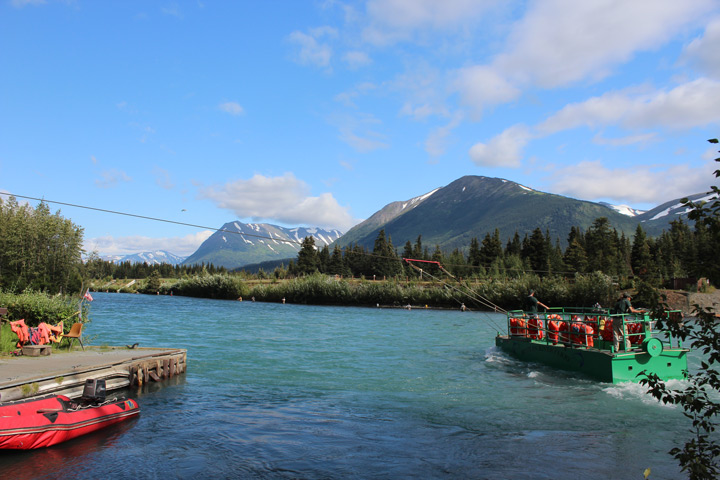
The Russian River ferry in action.

Salmon ready to make the big leap, at a salmon ladder just outside Seward.
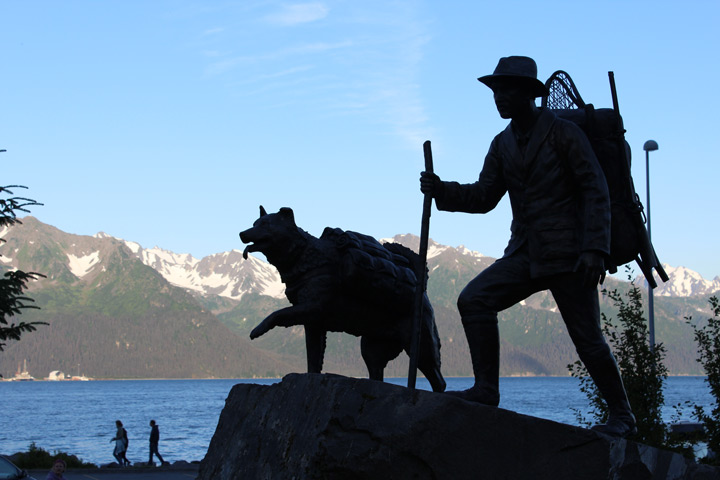
In the middle of Seward, a statue at the start of the Iditarod Trail.
Allyson celebrated the triumphant experience with another nap, as we drove right back the way we came. Our next big activity was based in Seward on the following day, so the afternoon was our opportunity to see the Kenai Peninsula. Or at least the 2 percent of it conveniently accessible by roads.
To my understanding, people from Anchorage treat the Kenai the way people from Washington treat the Chesapeake. On Fridays in the summer, people cut out of work early, load up their trucks and make the pilgrimage south. There's camping, hiking, ATVing and fishing on the Kenai. You can spend your time on a lake or river if you're in the middle of the peninsula, or you can shoot over to the west side and hang out in a coastal town. There's not much in the way of beaches. But if killing fish is your preferred way of unwinding from your stressful Anchorage desk job, there is no better option than the Kenai Peninsula.
We were driving this way on a Friday, and at first we were a little bit ahead of the rush. Instead of going straight back to Seward, when we got to the peninsula's big intersection (there's only one, because it's Alaska), we headed west to explore. After stopping for lunch at a roadhouse, we found that the trickle of weekend warriors was becoming the human equivalent of a salmon run -- if every salmon drove an SUV and was a really aggressive driver.
For aimless driving, you could do worse than the Kenai Peninsula. We didn't have a specific destination in mind, so at first we were just taking in the scenery of the peninsula's interior, which is all mountains and glacier-fed rivers. Eventually we hit the coast, and the towns of Soldotna and Kenai. They have the overall feel of a big strip mall. We glimpsed another historic Russian Orthodox church in Kenai, and we took in a scenic view of a bunch of guys fishing in the ocean. It was pleasant, but it wasn’t all that exciting -- especially after our morning of playing with death’s handmaidens. After looking around those towns for a few minutes, we made a mutual decision to head back.
To our great credit (because we are fantastic vacationers), the ride back to Seward ended up being way more eventful. Some of the scenery we zipped past earlier seemed to have roadside parking. Allyson said she was up for checking it out, within reason. Somewhere in the center of the peninsula, we parked on the shoulder and took a look at the Russian River Ferry, smack in the middle of the Chugach National Forest. This turned out to be a great idea. After a quick tromp along the road, we were staring at ridiculously blue water -- glacier-fed waters often take the color of whatever rock has been ground up by the ice. The Russian River looks like the Caribbean in spots, only with more fat white guys in rubber pants.
The place where we stopped is allegedly one of the most popular fishing sites in Alaska, as the flat and gravelly bottom of the river makes it very, very hospitable to salmon. And Alaskans are all about finding the easiest way to kill a lot of fish. This once made a lot of sense, as fish supplies had to last seven or eight months at a time. You needed to stock up as a matter of survival.
Alaska has grocery stores now, but sport fishing in the state often does not involve a lot of sportsmanship. Salmon and their ilk are always in a bit of a pickle. Biology tells them that they MUST return to their spawning grounds to reproduce. Their spawning grounds are upstream, and their bodies start deteriorating the second they start the journey. They are horny, tired, and incapable of making good decisions, because if they don't get where they're going in time, they don't get to participate in the salmon orgy -- and they literally die alone. It's like using a bikini car wash to lure teenage boys to their deaths.
You could see fish literally jumping out of the water as rows of guys in waders tied flies and got to casting. We didn't want to go fishing, because it involves touching gross fish. But it was cool to see a little bit of Alaskan culture in action. It was also cool to see the Russian River Ferry -- a glorified barge attached to a cable, so that fishermen can be dragged across the fast-moving water to the far side. The area (where the Kenai and Russian rivers meet) has been a fishing haven for centuries, and a lodge on the opposite side of the river had long housed many an angler. The ferry is partly pragmatic, and partly environmental -- to maintain salmon breeding grounds, there needs to be a certain amount of vegetation on the river banks. The ferry keeps people from stomping all over the banks and killing the vegetation. In addition to the ferry, you get the peculiar site of stairs leading directly into a fast-moving river, again to keep people off the banks.
Our interest was piqued by the raw animal excitement of fishing, so we planned one more stop for the afternoon. According to the helpful pamphlets I read at the Hertz facility, there was a salmon ladder on the outskirts of Seward, not far from Bear Lake. On our way back into town, we found the turnoff, drove up to some kind of parking area, and got very confused. It was a wooded area, and there was a stream running alongside the road. We thought that the stream might be the salmon equivalent of the 405. Instead, it looked like a regular stream. You couldn't walk across it on the backs of horny fish.
We were very close to leaving when I noticed a number of fish swimming in place, just in front of a small bridge where the stream crossed the road. They were putting out just enough effort to mark time. This merited further investigation, so we crossed the road ... and behind a few trees, around a bend in the road, we found the actual salmon ladder. It was not an impressive facility, as it was unmanned and the stream was less than 15 feet wide. But the entertainment value was enormous.
Salmon are the James Brown of the fish world, working harder for your amusement than you actually deserve, with terrible consequences for their bodies. The fish ladder featured a slightly deeper section of the stream, leading into a small man-made waterfall. Fish were queueing up in the deep water, screwing their courage to the sticking place, then making frenzied leaps trying to propel themselves past the waterfall. They had to swim frantically the millisecond they landed, or else the current would dump them right back where they started.
We watched for 15 minutes, and the success rate seemed to be zero. It was like watching a YouTube compilation of parkour fails. Salmon aren't extinct, so maybe we weren't seeing the salmon all-star team on this particular day. But the next time you wince at the cost of a fish dish in a restaurant, remember all the agony that went into that salmon just being born.
Having achieved total mastery of both salmon AND bears, we were ready to call it a day. We drove the last few miles back to Seward, and we checked into the Breeze Inn. It was a motel, and the room smelled like cigarettes. But it was affordable, and the motel lobby had a stuffed bear AND a stuffed mountain lion. Once the bags were dropped off, we took another look at all four blocks of downtown Seward. This included the Iditarod monument. The famous race was originally a mail route starting in Seward, so they have a nice statue of a guy and a dog pretty close to the waterfront. After soaking that in, we had dinner at the Chattermark, featuring a very good hamburger (for me) and some very good Alaskan beer (also mostly for me). It was vacation, so we even splurged and got some ice cream at a parlor across the street from the Breeze Inn. It was still broad daylight at 9 p.m. -- more on that later -- so it felt a little strange to be having dessert. But you get over it pretty quickly when you're pounding two scoops of moose tracks.
Day 10: Kenai Fjords
My father is a man of curious tastes. He likes awful science fiction, the music of Bob Dylan, and anchovies on pizza. As we have already discussed, he found the insanely exhilarating experience of walking on a glacier to be "boring." But I have seen him spend four straight hours in his back yard, cutting small twigs into smaller twigs. By hand.
Considering all this evidence, we probably should have been a little more skeptical before committing the tenth day of vacation to his recommendation. One of dad's great Alaska memories was cruising the Kenai Fjords. On the strength of that memory, I convinced Allyson that we should give it a shot. One of the first things we booked for our vacation (aside from the Sea Breeze, where we woke up that morning) was an eight-hour boat trip out of Seward to see a bunch of birds.
To be fair, it wasn't as dodgy as all that. Kenai Fjords is a National Park, and a massive one at that. It takes in a lot of the Kenai coastline, which has been mutilated and renovated by countless glaciers over the centuries. It's a stunning natural setting, but maybe not the easiest one to visit. Unless you have a kick-ass boat at your disposal.
As it turns out, tour companies tend to have kick-ass boats. We woke up at 6 a.m. to board one. After we checked out of the hotel, Allyson staggered around Seward to find some oatmeal at a local bakery, while I dropped the car at the tour company's parking lot, about a quarter mile from the harbor. We reconvened near the docks. Allyson mentioned 40 or 50 times that it was very early, and we boarded the Alaskan Explorer.
It looked like a bigger version of the S.S. Minnow, which is either a good omen or a terrible omen depending on your disposition. The Explorer has two decks, with interior cabins on each level. Those cabins include a snack bar, booth-style seating, and screens showing you satellite navigation maps. Apparently no one uses sextants or astrolabes anymore, because romance is dead.

Our chariot awaits! Ready to explore Kenai Fjords.
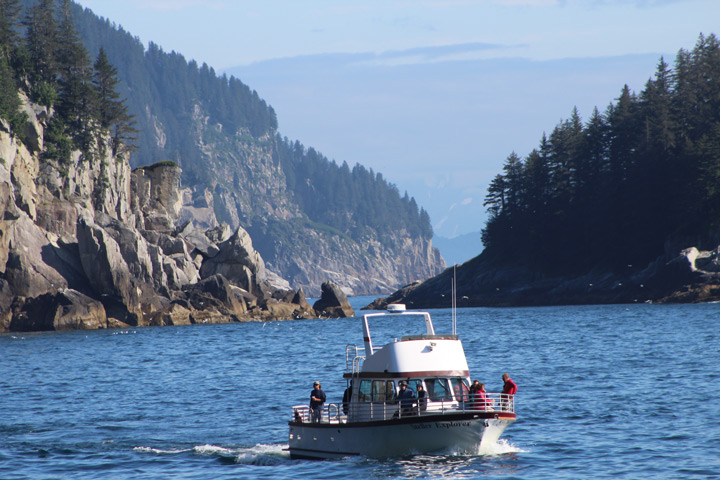
Kenai Fjords: Unmatched scenery and moderate nausea from rolling seas. Fun!

On the approach to Northwestern Glacier, seals were chilling out.
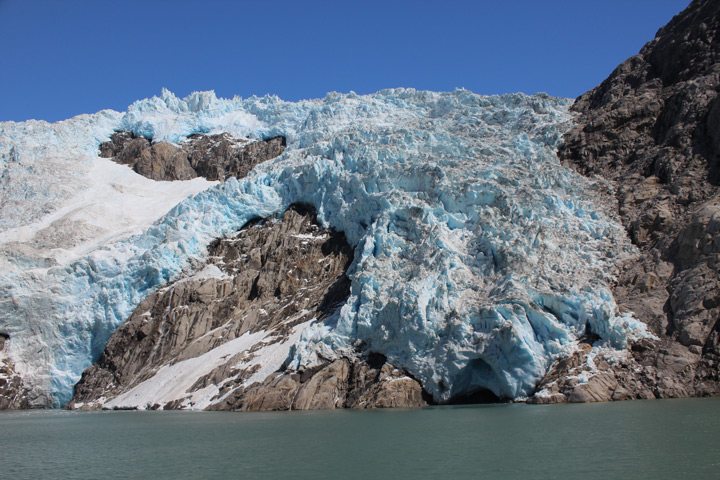
Up close and personal with Northwestern Glacier. Kenai Fjords.
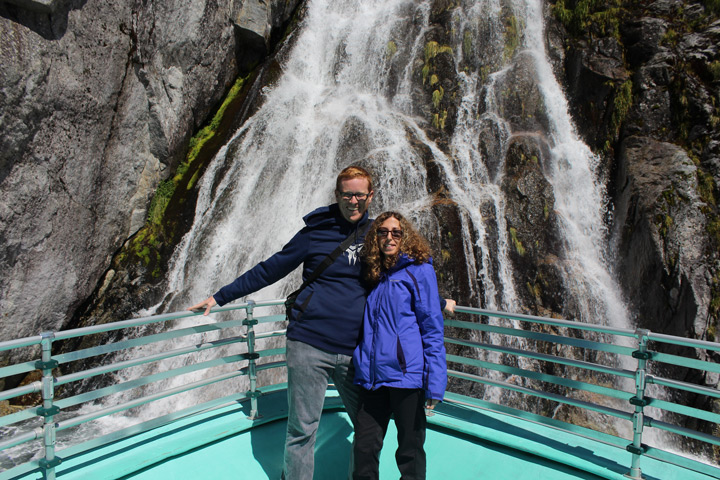
DO go chasing waterfalls. Kenai Fjords.
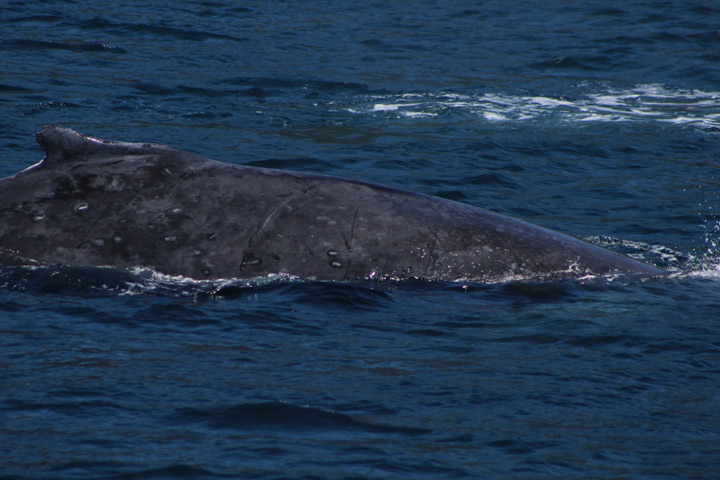
A little more whale-watching. We got some good looks at humpbacks.

Puffin, puffin, pass. Curious birds hanging out in a nesting area.

Stellar sea lions put on a show amid some crashing surf.
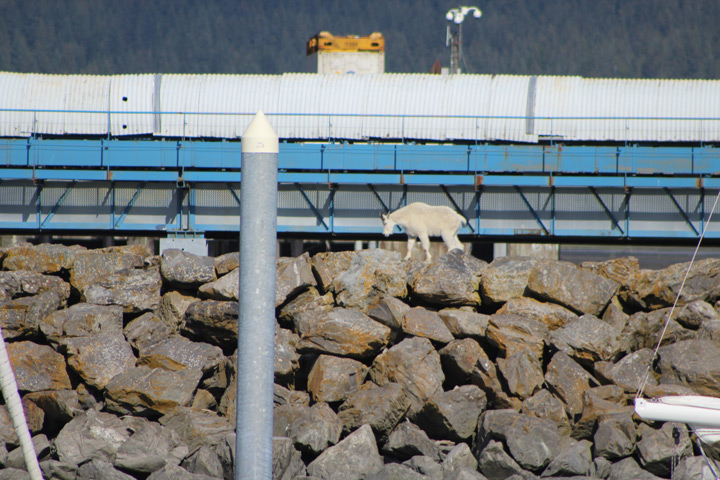
A mountain goat wandered (tragically) into unfamiliar territory in Seward harbor.
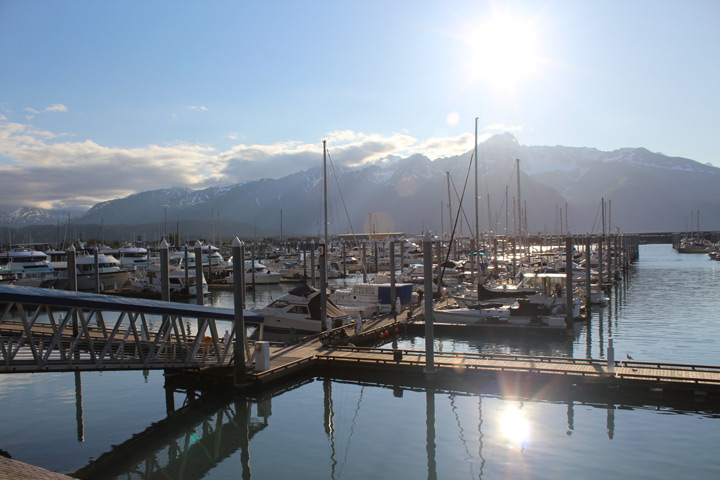
The stunning harbor at Resurrection Bay.
The ship is highly maneuverable, and the hull shape is perfect for navigating the fjords. The steep rock faces of the coastline mean there's lots of deep water very close to the shore, and the captains -- by virtue of doing this tour 100 times a summer -- know all the best spots to stop.
The downside of the Alaskan Explorer is that it's not a cruise ship. Once you leave Resurrection Bay (where Seward is), you're at the mercy of the seas. (And no one is walking around offering you drinks constantly.) The ship sways a lot, and if you have a weak stomach, it could be a loooong day.
We had been taking Dramamine as needed during the vacation, but that drug has the unfortunate side effect of zonking you out. We were a little reluctant to take it before boarding the Alaskan Explorer, because our day might involve a ton of conversation. You need to meet and greet your fellow passengers, to assess what skills they would bring to our possible island home in the event of a shipwreck.
We sat in an upstairs booth with Jim and Bonnie, a delightful couple from Minnesota by way of Indiana. They had DRIVEN to Alaska while towing an Airstream camper. They had some delightful stories about the unspeakable boredom and poor road maintenance on the Alaska Highway. Another nearby passenger was from South Carolina, but he was stationed in Anchorage with the Air Force doing procurement stuff, and would shortly be moving to the DC area with the Filipino bride he met online. Allyson finds online and arranged marriages fascinating -- maybe even more fascinating than aquatic life. It's either because she is completely unable to comprehend the mentality of the people involved, or she desperately wishes she had gone that route. I've decided not to investigate further until I'm served with papers. There was also a nice guy on board who was taking the tour for the eighth time. And voluntarily at that! He wasn't trapped in the bathroom or anything.
A blow-by-blow account of the trip would not be possible, because all the wonderfulness runs together. Instead, some bullet points.
- The route. The cruise headed south out of Resurrection Bay, the mountain-ringed body of water where Seward sits. We made our way along the coast to the south and west, zigzagging back and forth en route to Northwestern Glacier. Then we headed back, because I couldn't convince Jim and Bonnie to help me mutiny.
- The weather. It was almost perfect. We got cold at times, but for the most part there was bright sun and clear skies.
- The scenery. There was always land in sight, whether it was coastline or some giant slab of steep rock that nature turned into an island. Almost any surface flat enough to hold a few inches of topsoil was covered with enormous trees. Any surface that wasn't flat enough was covered with birds, or bird poop. Birdwatching is a big part of this tour. A few cliffs abutting the water were festooned with glacial waterfalls. At one point we parked at the base of a waterfall while everyone posed for photos at the bow of the ship. On the way out of that particular inlet we could see four waterfalls, each at least 1,000 feet tall. Thinking back on it, we all should have been weeping and praying to a deity; I'm thinking the Dramamine dulled our emotional response. One memorable footnote was the groves of dead trees that cropped up from time to time. In 1964 Alaska suffered an apocalyptic earthquake, the biggest ever recorded in America. It was felt over thousands of miles, and in Seward, parts of the coastline dropped about 10 feet, almost instantly. This destroyed a lot of the downtown, and mucked up the water table. The influx of seawater killed a lot of trees where they stood, and the trunks are still forming ghost forests 50 years later.
- The glacier. We had already done a drive-by of a glacier while on board the Celebrity Millennium, but the visit to the Northwestern Glacier -- named after researchers from the college who explored it -- might have been even cooler. Thanks to either the smaller size of this particular glacier or the smaller size of the Alaskan Explorer, we were able to get within about 1,500 feet of the ice. Because we were closer to the water, we also had a much better view of harbor seals hanging out on the icebergs. There was plenty of iceberg calving, and it was a lot easier to run from one side of the ship to the other when you wanted to change your view. Mixed drinks on deck would have been nice, but this was clearly the superior vessel for seeing a glacier.
- Cookies. At some point they served us cookies right out of the oven. They were yummy.
And as to the animals, who were the real stars of the show (sorry Jim and Bonnie) ...
- Harbor seals. The oompa loompas of the marine mammal universe. Harbor seals are on the smallish side. They're extremely cute, and probably very good in the water. But on land they kind of sit there and look awkward, like a fat guy trying to get out of a beach chair. They do have some excellent posing technique, however. They mostly want to sit on ice floes and not go anywhere. When a boat approaches, instead of turning their whole body to investigate, they just crane their very flexible necks into poses that would make Tyra Banks and noted fashion photographer Nigel Barker very proud.
- Stellar sea lions. We saw a lot of sea lions on this trip, in very dramatic settings. They keep hanging out on sun-soaked rocks, and the active tides ensured that lots of waves and spray were constantly floating around. Some sea lions were queueing up to get on the rocks, and trying to time the waves to get high enough to reach the rocks. It was like watching a very exciting line outside a nightclub in Baltimore. Also, the sea lions of Kenai Fjords uphold the proud sea lion tradition of appearing to yell at and fight each other constantly, like Italian families in the movies. It's a vibrant scene.
- Sea otters. This trip was our best exposure to sea otters, the lovable murderous clowns of the marine mammal community. If you watch a sea otter for a few minutes, it's clear that they are extremely smart. They actually use tools, keeping "favorite rocks" to smash open either shellfish or the heads of their enemies. They also can tear apart a fish with their bare hands. What makes sea otters so wonderful is that they can do all this while swimming on their backs. Their powerful tails do enough work to keep them afloat, and that keeps their precious little hands free for smashing or ripping. They use their bellies as work surfaces, in the way that you or I might balance a bag of chips on our stomach while watching TV. Otters also have cute button noses, and their fur is so adorable when it's wet. I am pretty sure that a sea otter could kill you in a fair fight, but you would probably die while saying "awwwwwwwwww!" We saw a few otters swimming in the vicinity of the boat. One was ripping apart a salmon. Another was bleating for some reason, and two more were hanging out in the Seward harbor in pursuit of a free lunch.
- Humpback whales. Our encounters at Icy Strait Point were more exhilarating, but we did spy more than a few humpbacks. Kudos to our ship captain, who saw a whale, positioned the boat, and waited in case the whale decided to dive. He wanted everyone to get a picture of a whale tail with a huge snow-capped peak in the background. That's service.
- Birds. Some would argue that a Kenai Fjords tour is for the birds, literally. They gave us a checklist at the start of the trip so we could track our bird sightings. There were thousands upon thousands of birds, either fishing in the ocean or nesting on the rock faces. They were swooping along and around the boat, diving into the water, or watching us with a wary eye. The most ubiquitous were gulls, and in that sense Alaska isn't THAT different from the Jersey Shore. But gulls seem a lot cooler in the Alaskan wilderness, as opposed to when they're eating cigarette filters out of the sand. The champion bird (for me at least) was the peculiar puffin. There were two species of puffin, and neither one seemed like it was genetically designed to fly. Puffins are great fishers, but once they take to the sky with their stubby little wings, they look like meth addicts with jetpacks. The guy providing commentary on the boat informed us that part of the problem was overeating. When puffins chow down, they can consume enough that the added weight makes it tough for them to take off. You can see puffins flapping furiously, but only skipping across the surface like a stone. It's hilarious.
- A mountain goat. On our way back into the harbor, the captain told us that we were about to see something very unusual. The guys on the radio told him that a mountain goat was walking on the spit at the entrance to the docks. It had wandered into the town and lost its bearings. Now it was trying to find a way back to high ground. This was a cute incident at the time, but it became horrifying within a few weeks. We read online that tourists with cameras kept pursuing the frightened goat, to the point where it jumped into the Seward harbor and drowned to death. Yikes.
We made it back to port without any terrible seasickness. And our opinion of my dad's opinions was relatively unharmed. I thought the cruise was fantastic -- I am genetically inclined (via my father) to enjoy watching birds. Allyson enjoyed it, but she had scenery fatigue. If you eat five-star meals every day, you might need a few days of Hardee's to appreciate the good stuff again. Also, while this was a once-in-a-lifetime experience, we were not allowed to drive the boat. That would have kept Allyson alert, because the screams of other passengers have a way of doing that.
Those minor quibbles aside, it was a fantastic way to spend the day, and we celebrated with dinner at another road house just outside of Seward. There we talked to ANOTHER couple from Minnesota, Ozzie and Denise. They were on a vacation to celebrate their retirement, and they were a lot of fun, because they looked like biker gang refugees.
The only thing left to do in Seward was leave. We headed north on the highway, past the conservation center. It's another beautiful stretch of road, winding along the Turnagain Arm and crisscrossing the rail lines that connect Seward to Anchorage. We pulled over to glimpse a few more mountain goats on a hillside next to the road, and we cruised through the marshes south of the city. And just a few hours after leaving Seward, we were in the BIGGEST CITY IN ALASKA!
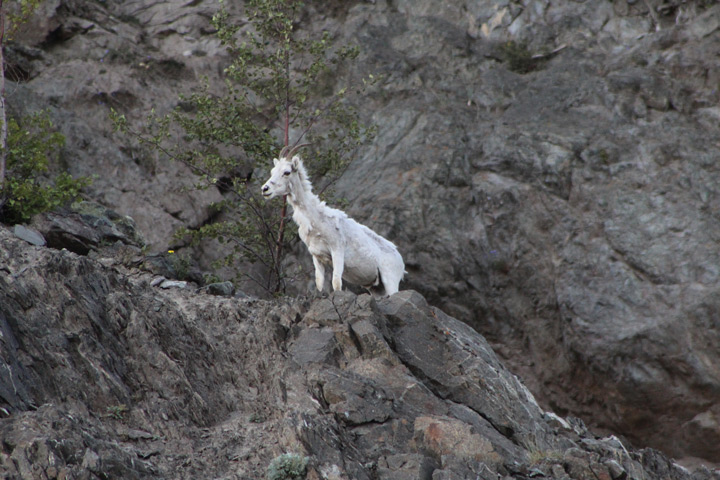
A mountain goat says hey on the road from Seward to Anchorage.
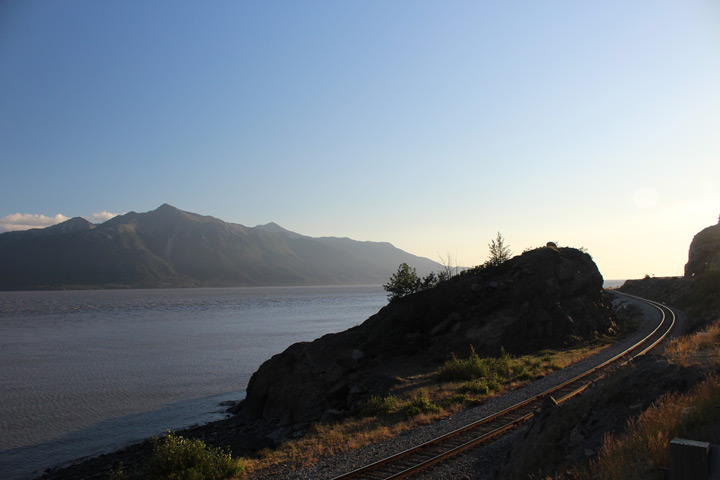
Scenic train tracks along the Turnagain Arm.

The view from the top of our Anchorage hotel ... at 11 p.m.
Anchorage, however, doesn't have a big city feel. The geographic footprint of the city is enormous, so the population isn't stacked vertically. It was easy to find our hotel (the Sheraton) because it was one of the only buildings in town that was 10 stories or more. You couldn't miss it if you wanted to. Once we were settled into our room, we went to the special "super customer" lounge for a panoramic view of the city. There's nothing much to obstruct your view, so it's fantastic. All of downtown is to the west, and the northern skies are buzzing with planes -- some from the city's smaller commercial airport, others from Elmendorf Air Force Base. It was pushing 11 p.m., but because this was Alaska, we even got to watch the sunset.
The sun never sets on an Alaskan vacation, however! It just barely dips below the horizon for a few hours. Even so, from what we could see out the Sheraton's windows, it seemed like we could afford six to eight hours of sleep and still conquer the entire city the next day.
